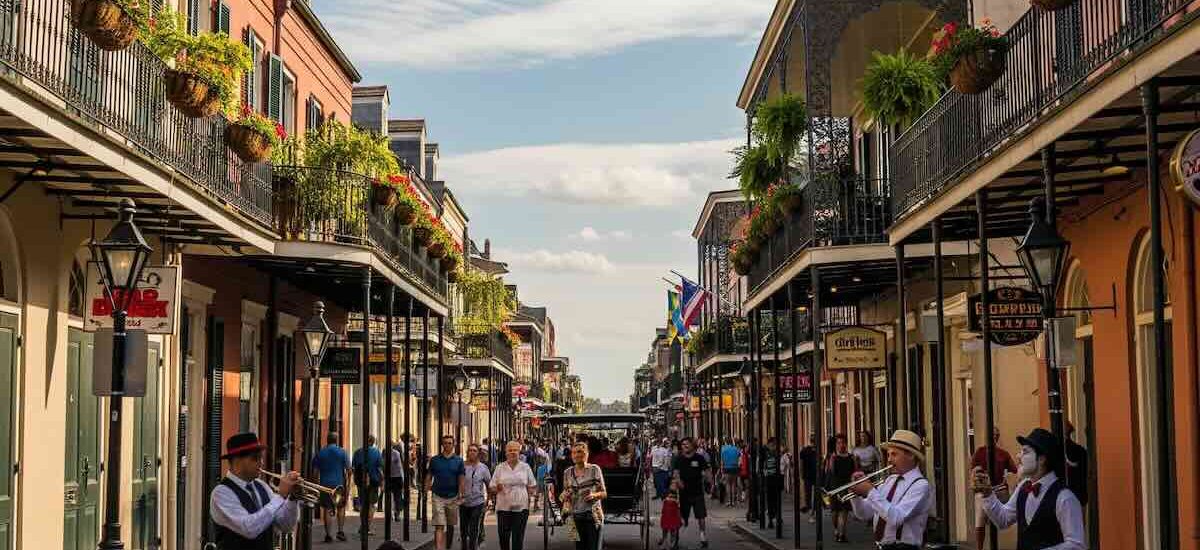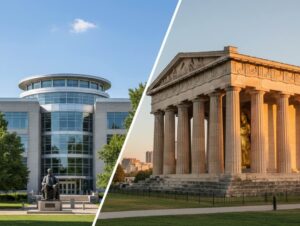New Orleans is known for its food, music, culture and, for many, its crime rate. Is New Orleans safe? The city’s safety reputation has long been debated, especially among those considering relocation or extended stays. But the answer isn’t a simple yes or no. Safety in New Orleans depends heavily on location, lifestyle, and awareness.
How Safe Is New Orleans in 2025?
According to the New Orleans Police Department’s 2024 year-end report, violent crime fell sharply citywide. Homicides dropped 35% from the previous year, while carjackings declined by 49%. Aggravated assaults and robberies also fell more than 40%. Property crime followed the same downward trend, with a 32% decrease, driven by reduced burglaries and thefts. These improvements came as the city invested in community policing, added mobile patrols in key corridors, and increased funding for youth outreach and surveillance tools.
However, New Orleans remains statistically one of the more dangerous large cities in the U.S. According to NeighborhoodScout, the combined violent and property crime rate is about 64.9 per 1,000 residents as of early 2025. That’s higher than national averages and places New Orleans in the lowest 10% of U.S. cities for overall safety. For comparison, the national average is closer to 23 per 1,000 residents.
The majority of violent crime is concentrated in specific neighborhoods and during late evening hours. Residents in areas like Lakeview or Audubon report significantly lower risk, while neighborhoods such as Central City and Saint Roch report much higher rates. As such, understanding where you live—and your proximity to higher-crime corridors—is a major factor in overall safety.
New Orleans Crime Trends: 2023 vs. 2024
Citywide Crime Reductions: New Orleans saw major year-over-year drops in key crime categories between 2023 and 2024.
Source: NOPD 2024 Year-End Report
View Full Crime Data Table
| Crime Type | 2023 | 2024 | % Change |
|---|---|---|---|
| Homicides | 265 | 172 | −35% |
| Carjackings | 300 | 153 | −49% |
| Aggravated Assaults | 4100 | 2419 | −41% |
| Property Crime | 18300 | 12444 | −32% |
Violent vs. Property Crime
It’s important to distinguish between types of crime when evaluating safety. Violent crime in New Orleans includes aggravated assaults, robberies, and homicides. These are more concentrated in specific high-risk neighborhoods, and typically occur late at night or in areas with low visibility and foot traffic.
Property crime, such as burglary, theft, and auto theft, is more common and spread across more areas. In 2024, theft accounted for more than 11,000 reported incidents, while auto theft exceeded 4,000 cases. Many residents install home surveillance, use steering wheel locks, and park in well-lit areas to mitigate this risk. The good news: both violent and property crime saw double-digit percentage drops citywide in the past year.
Migration & Moving Trends in New Orleans (2024)
In 2024, New Orleans and Louisiana continued a pattern of outbound migration. According to the U.S. Census Bureau and state migration studies, Louisiana ranked 44th in the nation for net domestic migration between July 1, 2023 and June 30, 2024. On average, more residents moved out of the state than moved in, even though small gains from international migration helped offset overall loss.
Data from the 2023 Coastal Moving Migration Report found that 56.7% of moves handled by us in Louisiana were outbound, compared to 43.3% inbound. Among those leaving New Orleans, top destinations included Houston, Dallas, Austin, and Denver.
Lakefront parishes like East Baton Rouge and Ascension saw modest inbound migration, but New Orleans Metro was identified as one of the fastest shrinking metro areas by net domestic migration, declining by nearly 5.7% between 2020 and 2023.
Despite these trends, many New Orleans renters are staying put. Axios analysis of census data shows that approximately 17% of renters have lived in the same home for at least 10 years, up from just 8.3% a decade earlier. Meanwhile, over one-third of homeowners indicate they will never sell their property.
These trends reflect both a challenging housing market with high rental rates and homeownership barriers and a community of long-term residents who choose stability over relocation. In short, moving away remains more common than moving in, but those who stay often do so by choice, valuing local roots over mobility.
Safest Neighborhoods in New Orleans
Not all parts of New Orleans are high-risk. In fact, several neighborhoods have consistently ranked as safe, stable, and ideal for families or professionals.
- Lakeview: Located near City Park, Lakeview offers suburban quiet within city limits. The area has low crime rates, excellent public schools, and access to green space.
- Newcomb Boulevard: Situated near Tulane and Loyola universities, this area is known for its walkability, low violent crime rate, and high population of long-term residents and faculty.
- Algiers Point: On the west bank of the Mississippi River, this neighborhood is quiet, community-focused, and more isolated from higher-crime zones.
- Audubon: A favorite among families and professionals, Audubon combines walkable streets, proximity to the zoo and park, and low rates of both violent and property crime.
These neighborhoods not only experience less crime, but also benefit from more active neighborhood associations, street lighting, and police presence. Home values in these areas tend to be higher, and properties often come with enhanced security features like gates, cameras, and monitored alarm systems.
High-Risk Areas to Approach with Caution
While the city overall is making progress, some neighborhoods continue to struggle with higher crime levels. These include:
- Central City
- Saint Roch
- Seventh Ward
- Desire Area
- Florida Projects and parts of the Lower Ninth Ward
These areas often face long-term economic challenges, limited public investment, and fewer community programs. They also see a disproportionate number of violent crimes, particularly during late hours. While many people live in these areas safely, they are not typically recommended for newcomers unfamiliar with the local layout or without connections in the community.
Public Safety Initiatives & Police Reform
New Orleans has undertaken several reforms to reduce crime and increase public confidence in recent years. In addition to hiring more officers and improving emergency response times, the city has rolled out gun buyback programs, invested in youth services, and implemented community-based policing models. A Cold Case Unit was also established in 2024 to help resolve longstanding violent crime cases.
However, some surveillance programs such as Project NOLA’s facial recognition network have come under scrutiny and were paused in 2025 amid privacy concerns. That said, most residents report improved response times and more visible law enforcement during events and in core tourist districts.
Living in New Orleans Day to Day
Daily life in New Orleans depends heavily on where you live and how well you understand the city’s rhythms. In well-established residential neighborhoods like Lakeview, Audubon, and the Garden District, residents enjoy quiet mornings, active parks, and walkable streets lined with historic homes and local shops. People walk dogs along Bayou St. John, bike through City Park, and shop at weekend markets without issue. These areas feel more like peaceful towns than sections of a major city.
But like any urban center, New Orleans demands local awareness. Most residents take small but consistent precautions: parking under streetlights, avoiding unfamiliar blocks at night, and installing security systems or cameras. Crime is often opportunistic, unlocked cars, open doors, or tourists not paying attention. In high-traffic areas like the French Quarter or Marigny during festival season, it’s common for pickpocketing and petty theft to spike.
Parents with school-aged children often choose Lakeview, Uptown, or Metairie for access to better-performing public and private schools. These zones offer both safety and educational infrastructure without requiring a full suburban departure. Young professionals relocating for tech, energy, or healthcare roles often favor neighborhoods like Mid-City or Algiers Point, which balance character, affordability, and proximity to employers.
Ultimately, living in New Orleans means participating in its community, not just observing it. That means knowing your neighbors, understanding the street grid, and adapting to a city where charm and complexity go hand in hand. For those who embrace the cultural pulse and stay alert, the city offers a lifestyle unlike anywhere else in the U.S.
Summary: Is New Orleans Safe?
- Citywide crime dropped significantly in 2024, with major declines in homicides, assaults, and property crimes.
- Safety varies dramatically by neighborhood. Some areas remain high-risk, while others are comparable to national averages.
- Safer neighborhoods include Lakeview, Audubon, Newcomb Boulevard, and Algiers Point.
- Risk can be mitigated with location awareness, basic security, and lifestyle adjustments.
- Ongoing police reform and neighborhood initiatives show positive momentum for 2025.
long distance moves
as low as $1748
Long-distance moving all across the United States. Experienced and insured, residential and commercial.
4.9/5 AVERAGE RATING
Need Help Moving to a Safe Area in New Orleans?
At Coastal Moving Services, we know the local landscape. Our team can guide you through choosing the right neighborhood, planning your relocation, and making sure your move is smooth and secure. Whether you’re coming for work, school, or a fresh start, we help you get there safely and confidently. Check out other safety article about Philadelphia.
Call us today at +1-334-659-1878








